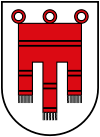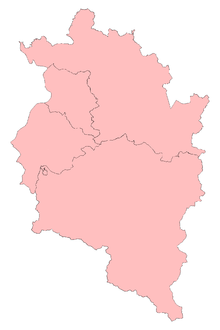Vorarlberg
| Vorarlberg | |||
|---|---|---|---|
| State of Austria | |||
| |||
| Anthem: Du Ländle, meine teure Heimat | |||
 | |||
| Coordinates: 47°14′37″N 9°53′38″E / 47.24361°N 9.89389°ECoordinates: 47°14′37″N 9°53′38″E / 47.24361°N 9.89389°E | |||
| Country |
| ||
| Capital | Bregenz | ||
| Government | |||
| • Governor | Markus Wallner (ÖVP) | ||
| Area | |||
| • Total | 2,601.48 km2 (1,004.44 sq mi) | ||
| Population (January 1, 2017) | |||
| • Total | 388,711 | ||
| • Density | 150/km2 (390/sq mi) | ||
| Time zone | UTC+1 (CET) | ||
| • Summer (DST) | UTC+2 (CEST) | ||
| ISO 3166 code | AT-8 | ||
| NUTS Region | AT3 | ||
| Votes in Bundesrat | 3 (of 62) | ||
| Website | vorarlberg.at | ||
Vorarlberg (German pronunciation: [ˈfoːɐ̯ʔaʁlbɛʁk]) is the westernmost federal state (Bundesland) of Austria. It has the second-smallest area after Vienna, and although it has the second-smallest population, it also has the second-highest population density (also after Vienna). It borders three countries: Germany (Bavaria and Baden-Württemberg via Lake Constance), Switzerland (Grisons and St. Gallen) and Liechtenstein. The only Austrian state that shares a border with Vorarlberg is Tyrol to the east.
The capital of Vorarlberg is Bregenz (29,500 inhabitants), although Dornbirn (48,700 inhabitants) and Feldkirch (33,000 inhabitants) have larger populations. Vorarlberg is also the only state in Austria where the local dialect is not Austro-Bavarian, but rather an Alemannic dialect; it therefore has much more in common culturally with its (historically) Alemannic-speaking German-speaking Switzerland, Liechtenstein, Swabia and Alsace than with rest of Austria, southeastern Bavaria, and South Tyrol.
Vorarlberg is almost completely mountainous and has been nicknamed the ‘Ländle’ meaning ‘small land’.
Geography
The main rivers in Vorarlberg are the Ill (running through the Montafon and Walgau valleys into the Rhine), the Rhine (forming the border with Switzerland), the Bregenzer Ache and the Dornbirner Ach. One of the shortest rivers is the Galina. Important lakes, apart from Lake Constance are Lüner Lake, Silvretta Lake, Vermunt Lake, Spuller Lake, the Kops Basin and Formarin Lake; the first four were created for the production of hydroelectric energy. However, even before the dam for the power plant was built, Lüner Lake was the largest mountain lake in the Alps. Most of this hydroelectric energy is exported to Germany at peak times. At night, energy from power plants in Germany is used to pump water back into some of the lakes.
As there are several notable mountain ranges in Vorarlberg, such as the Silvretta, the Rätikon, the Verwall and the Arlberg, there are many well-known skiing regions (Arlberg, Montafon, Bregenzerwald) and ski resorts (Lech, Zürs, Schruns, Warth, Damüls, Brand and many more).
Lech is an exclusive ski resort on the banks of the river Lech. In recent years Lech has grown to become one of the world's premier ski destinations and the home of a number of world and Olympic ski champions. With some other neighbouring villages Lech created the largest connected ski area in Austria and one of the largest in Europe. Together these villages form the Arlberg region, the birthplace of the modern Alpine skiing technique and the seat of the Ski Club Arlberg. Lech is a popular holiday destination for Royal families and celebrities, for example Jason Biggs, Tom Cruise, Diana - Princess of Wales, and the former Queen Beatrix and the Dutch Royal family.
Damüls is also recognized as the municipality with the most annual snowfall worldwide: on average 9.30 metres (30.5 ft). The highest mountain is Piz Buin, whose rocky peak of 3,312 m (10,866 ft) is surrounded by glaciers. Vorarlberg is supposed to enjoy the greatest scenic diversity within limited confines in the entire Eastern Alps; it adjoins the Western Alps. The distance from Lake Constance and the plains of the Alpine Rhine valley across the medium altitude and high Alpine zones to the glaciers of the Silvretta range is a mere 90 km (56 mi).
Administrative divisions
Vorarlberg is divided into four large districts, from north to south: Bregenz, Dornbirn, Feldkirch and Bludenz. These districts appear on the automobile license plates in form of abbreviations: B, DO, FK and BZ.
Demographics
The population of Vorarlberg is 388,711 (2017). The majority (86%) of residents are of Austrian-Germanic stock with a cultural connection with Switzerland and Liechtenstein to the west and Germany to the north. A sizable proportion of the population's ancestors came from the Swiss canton of Valais in migrations of "Walsers", including the Swiss French in the 19th century by invitation during the days of the Austro-Hungarian Empire. . There has been a sizable minority of Turkish descent since the 1960s.
Religion
78% of the population are Roman Catholic, which puts Vorarlberg in line with the national Austrian average of 73.6%. The second-largest denomination, with a share of 8.4%, is Islam, mostly Turks. 7,817 (or 2.2%) of Vorarlberg's inhabitants are Protestants.
Economy
Location
For several years, the Vorarlberg economy has been performing well above the Austrian average. While the overall Austrian GDP in 2004 rose by 2.0% in real terms, Vorarlberg recorded an increase of 2.9%. This came as a surprise, particularly as the major trading partners in Germany and Italy did not fare well. Owing to this robust economic performance, Vorarlberg was able to boost its gross regional product in 2014 to 15.2 billion EUR according to the Economic Policy Department of the Vorarlberg Chamber of Trade. This translates into a nominal increase of 3.4% (cf Austria as a whole +5.2%).[1] The regional product per inhabitant in Vorarlberg is 41,000 EUR, exceeding the Austrian national average by 8%. Vorarlberg and especially the Rhine Valley is one of the wealthiest areas in the world, with a very high standard of living. By far the biggest company in Vorarlberg is Alpla (plastic packaging), followed by Blum, Grass, Gebrüder Weiss (transport and logistics), Zumtobel Group (lighting systems), Doppelmayr (cablecars), Rauch (beverages) and Wolford (textiles).
Currently, five breweries are located in Vorarlberg: Mohrenbrauerei August Huber (in Dornbirn, since 1851), Brauerei Fohrenburg (in Bludenz, since 1881), Brauerei Egg (in Egg, since 1894), Vorarlberger Brauereigenosschenschaft - Brauerei Frastanz (in Frastanz, since 1902), Grabhers Sudwerk (in Bregenz, since 2017).
Overall, the economic expansion of Vorarlberg is "very positive and for the future rated more dynamic than for the other federal states".[2]
Agriculture
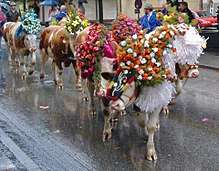
In addition to the flourishing textile, clothing, electronics, machinery and packing materials industries of the Alpine Rhine Valley, there is also a broad agricultural base, especially in the Bregenz Forest (Bregenzerwald), which is noted for its dairy products (especially due to the "KäseStrasse Bregenzerwald",[3] an association of farmers, restaurateurs, craftspeople and traders promoting the Bregenz Forest agriculture and its local products) and tourism.
Another important economical and cultural factor is the three-level agricultural structure of the mountain-regions in Vorarlberg. It is also known as Alpine transhumance and describes a seasonal droving of grazing livestock between the valleys in winter and the high mountain pastures in summer. Many cultural habits like Yodel, Alphorn or Schwingen were developed during this time. This seasonal nomadism led to the rich culture, architecture and love for nature found in Vorarlberg. A significant cultural icon unique to this area is the festive movement of cattle, from the pastures to the villages. This tradition is popular with tourists.
Energy sector
The energy sector is one of the founders of Vorarlberg's economy, in which hydropower is the most important source of energy. This is mainly used for the production of peak current. Vorarlberg was the first region in Europe where more sustainable energy was produced than consumed. Green electricity from Vorarlberg is therefore also sold to the German Westallgäu, to Switzerland and to other Austrian provinces. The largest electricity producer in Vorarlberg is Illwerke AG. They produce 75% of the stream in Vorarlberg, mainly by hydropower.[4]
Culture
Language
Owing to their location isolated from the rest of Austria, most people in Vorarlberg speak a very distinct German dialect that other Austrians might have difficulty understanding, since the dialects in the rest of Austria form part of the Bavarian-Austrian language group, whereas the Vorarlberg dialect is part of the Alemannic dialect continuum. Alemannic dialects are also spoken in Liechtenstein, Switzerland (as Swiss German), Baden-Württemberg, the south west of Bavaria and the Alsace region of France. The Vorarlberg dialect is further divided into a number of regional sub-dialects (e.g. that of the Montafon, the Bregenz Forest and Lustenau are some of the most distinct) which tend to differ considerably from each other. In fact even within these regions the dialects may vary from one town or village to the next.
Traditional garb
Traditional costumes ("Tracht") have a long history in Vorarlberg. Many valleys and villages have their own kind of garb, each with special characteristics from certain style periods. The Bregenzerwälder garb is the oldest, it originated in the 15/16th century and is also called "d'Juppô" (Bavarian: "Juppe"). The Montafon garb is inspired by the baroque era. A whole set of Tracht consists of several elements: the "Juppe" (the apron), a headgear (caps, hats), a blouse, a "Tschopa" (jacket), and stockings. The hairstyle (for example braided hair) can also be part of the Tracht.
In the 1970s, very few Vorarlbergers wore Tracht. The reason for this was strict regulations with regard to the people wearing Tracht. For example, Bregenzerwälder ladies with short hair ought not to wear Tracht, because their hair was too short for the suitable hair style ("Wälderzöpfe"). It was only when the regulations were loosened and the clothes were individualised in the 1990s that wearing Tracht became more popular. Today, traditional garb is mainly worn on festive occasions. In Riefensberg, Tracht is still traditionally manufactured.[5] There is a "national association for people wearing traditional costume" (Landestrachtenverband) that supports Vorarlberg's Tracht wearing inhabitants and music chapels.[6]
Vorarlberg's cuisine

The influence of the Alemannic cuisine of neighbouring countries works more on Vorarlberg cuisine than Austrian cuisine. Cheese and other dairy products play a major role in traditional Vorarlberg meals. Typical dishes from the Vorarlberg region are: Käsespätzle or Käsknöpfle (noodles of flour and eggs with cheese and onion), Riebel (dish of corn and wheat semolina, served spicy or sweet), Flädlesuppe (broth with savoury pancake stripes), Grumpara mit Käs (peel pastry with cheese), Öpfelküachle (apples baked in pancake dough, topped with sugar and cinnamon). Furthermore, Mostbröckle (pickled and smoked sausage), originally from Switzerland, is a very popular product.[7]
Regional dairy products
- Bergkäse (literally "mountain cheese"). The texture of the Bergkäse is rather hard, sometimes with small holes or cracks, with a strong taste, which is sometimes nutty. In the strict sense, Bergkäse is a cheese produced in the low mountain range (between 600 and 1500 m). Examples of Vorarlberg's Bergkäse are the Vorarlberger Bergkäse or Großwalsertaler Bergkäse named "Walserstolz".
- Alpkäse (literally "mountain pasture cheese" or "alp cheese"). Alpkäse is a hard cheese that resembles Bergkäse in taste and texture. The difference between these cheeses lies in the period and place of production. Bergkäse is produced year-round, so even in winter, when the animals are in the stables and fed with hay. Alpkäse, on the other hand, is only produced in the summer between May and September on high mountain meadows above 1500 m (Alpine pastures or alps), where the animals graze Alpine herbs. Alpkäse is therefore a seasonal product. An example is the Vorarlberger Alpkäse.
- Sura Kees (literally "sour cheese"). Originally from the Montafon valley, Sura Kees has been known there since the 12th century and resembles the Tyrolean gray cheese. It is a low-fat cheese with a mild aroma reminiscent of cream cheese, its taste varies from mildly spicy to sour, always with a salty undertone. The Sura Kees is usually served with vinegar, oil and onions, pure on black bread or eaten to potatoes.[8]
Architecture
The architectural curriculum in Vorarlberg has a strong reputation all over Europe. It has made a label for a demanding architecture of a fruitful confrontation between traditional construction and modern interpretation with the "Neue Vorarlberger Bauschule" (literally: new Vorarlberg building school). The Vorarlberg school evolved organically the second half of the 20th century, always involving craftsmen and locals in the building process. Today, it is regarded as one of the most important pioneers of the New Alpine architecture. With the typical architecture of Vorarlberg still recognizable, it combines tradition and modernity: clean lines, glass and local wood. Its harmonious mix creates interesting contrasts as in half-timbered houses. Comfort and quality of life are important criteria. Currently, many private houses and public buildings are renovated by architects, favoring local timber and limiting energy expenditure.[9] Well-known award-winning architectural projects include the Kunsthaus Bregenz, Vorarlberg museum in Bregenz, Michelehof Hard and Hotel Krone Hittisau.[10]
"Over the last thirty years, […] Vorarlberg has made a name for itself with its contemporary building culture. Widely considered a unique phenomenon throughout Europe, Vorarlberg has not only established its own regional identity, but also serves as a role model far beyond its own borders. […] The employment of innovative materials and construction principles, the integration of the latest technologies, and the development of new building products play a particularly important role. […] The harmonious collaboration between architects, craftsmen, clients, and the local authorities continues to produce new architecture which is progressive, energy-efficient, and sustainable, and has earned Vorarlberg a widely admired reputation in the international design community."
— Ulrich Dangel (2010), Sustainable Architecture in Vorarlberg: Energy Concepts and Construction Systems
A modern example for Vorarlberg architecture is located in Dornbirn. From 2010 onwards, Vorarlberg had been investing in research on renewable energy sources and energy-efficient houses in order to achieve self-set climate targets. In 2012, the first modular wooden hybrid complex of eight floors was built: The LifeCycle-Tower ONE (LCT ONE). It is 27 meters high and made of wood and concrete. In this architectural design, load-bearing elements are not covered. The benefits of this innovative project are environmental and energy efficiency, 90% less CO2 emissions, a much shorter construction and industrial production time of the components.[11]
Occupying the Werkraum Bregenzerwald since 2014, the travelling exhibition Getting Things Done demonstrates the quality of Vorarlberg's architecture by means of 230 selected projects. It offers a distinct view of how building culture has evolved from the late 1950s until the present. Organized by the Austrian Cultural Forum network, the exhibition will be show in over 20 locations around the world.[12]
Architecture Trails
The Vorarlberger Institute for Architecture and the Vorarlberg Tourist Board developed in collaboration architecture trails including village spaces, art & culture, timber & material, old & new, crafts & innovation and nature & landscape. These tours take visitors to both urban and rural regions in order to illustrate architectural variety in Vorarlberg by select examples. These examples are characterized by a functional mix, spatial versatility, formal radicalism, ecological far-sightedness and social integration.[13][14]
Bus Stop Krumbach
In 2014 Krumbach (municipality in Bregenzerwald) constructed 7 small bus stops that were designed by international architect offices in partnership with local partner architects and craftsmen. These extraordinary bus stops received special recognition as part of the Austrian National Architecture Awards as well as the National Award for PR.[15]
Traditional architecture
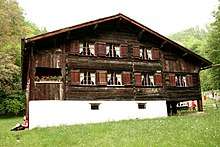
With regards to traditional architecture, Vorarlberg is known for many baroque architects. These architects created their own take on the canonical church ground plan, referred to as "Vorarlberger Münsterschema". An important builder's guild was the "Auer Zunft" (Guild of Au), founded in 1657 by Michael Beer. The Auer Zunft trained around 200 baroque architects, stonecutters and carpenters in the 17th and 18th century. The craftsmen of the Auer Zunft created a large number of buildings in Vorarlberg, in Switzerland, in Alsace and in the South German region.[16][17]
The independent architecture of the "Bregenzerwaldhaus", the "Walserhaus" and the "Montafonerhaus" are particularly relevant to historical architecture.[18] Their designs trace back to the 15th century. The traditional materials used for building these houses are stone and wood. They're important features of the mountainous Alpine landscape.[9]
Tourism
The tourist industry employs a considerable number of Vorarlbergers. There are around 12,000 employees working in this industry which represent approximately 11% of the total workforce (107,575 in 2015).[19]
Arrivals are slightly higher in winter (1.23 Mio in 2015) than in summer (1.14 Mio in 2015). The real difference lies in overnight-stays indicating that Vorarlberg is a strong winter destination. Overnight-stays in winter reach as high as 5.11 Mio which is quite large when compared to summer with 3.7 Mio overnight stays.
The greatest tourist attractions are the mountains and the numerous ski resorts. In the cold season, winter sports enthusiasts will find ideal conditions for their favourite sport: skiing, cross country skiing, freeriding, snowboarding, ice skating, sled dog rides, carriage rides, tobogganing, snow and fun parks. Due to its unique location in the mountains it is also possible to cross Vorarlberg on skis. "Ski Ride Vorarlberg"[20] is a combination of skiing, touring and freeriding and takes tourists from the Kleinwalsertal in the north to the Montafon in the south. The tour takes place in a small group and is accompanied by a guide. The route takes them through open terrain and on-piste ski areas – whatever is available. A notable ski area is Damüls-Mellau which is popular for its snow safety.

In the summer all mountain sports are in the foreground: hiking, mountain biking, trail-running, but also resting and boating on Lake Constance. In total, Vorarlberg has more than 5,500 kilometers of hiking trails in different heights for both experienced and inexperienced walkers. The theme route "Gauertaler AlpkulTour", which extends through the cultural landscape of the Montafon in the Rätikon mountains, is a popular walking route among tourists. Lake Constance is a pivot for hikers and pilgrims. For a long time, it has served as a reference point for important pilgrims' paths, including the Lake Constance walking path, parts of the pilgrimage route to Santiago de Compostela and the European hiking routes E1, E4 and E5.[21][22]
The largest (and best-known) touristic regions are:
- the Bregenz Forest,
- the Bludenz-District
- the Arlberg region (including the high-class ski resorts Lech and Zürs),
- the Brandnertal
- the Montafon
- the Kleinwalsertal and
- the Großwalsertal
Skiers from these regions include Anita Wachter, Egon Zimmermann, Gerhard Nenning, Mario Reiter, Hubert Strolz, and Hannes Schneider, as well as the ski-jumper Toni Innauer.[23]
Biosphere reserve Großwalsertal
The Großes Walsertal Biosphere Reserve covers 19 200 ha, 3400 inhabitants and around 180 farms (40% of which are organic). The reserve strives for a sustainable economy and tourism in the region and provides a platform for discussion about society, politics and science. The Biosphere Reserve Großes Walsertal has been a UNESCO biosphere reserve since 2000. Biosphere reserves are the ecological counterpart of the cultural world heritage sites.[24]
Festivals
Aside from sportive offers, Vorarlberg provides cultural attractions of all kinds. The Bregenzer Seefestspiele is the best known festival of the region and poses one of Austria's cultural highlights since 1946. It annually takes place in the months of July and August. With operas and musicals such as Die Zauberflöte (The Magic Flute), West Side Story and Carmen, the Bregenzer Festspiele draws hundreds of thousands of spectators every year. Noteworthy is the Seebühne, an impressive stage in Lake Constance where scenes are played.[25]
The Poolbar Festival is a modern music and culture festival in Feldkirch. Being held annually between July and August, it attracts around 20,000 visitors featuring music, exhibitions, poetry slams, fashion and an architectural prize.[26]
The annual Schubertiade in Schwarzenberg is the most important Franz Schubert festival worldwide. A Schubertiade is usually dominated by Franz Schubert or his compositions. It is an informal meeting where casual music is played or recited by friends clubs or musicians, both on a professional and amateur level. The first Schubertiade took place in Hohenems in Vorarlberg in 1976.[27]
In addition, there are many museums and attractions such as the Kunsthaus Bregenz, the Vorarlberg Museum, the Jewish Museum of Hohenems and the Wälderbähnle (Bregenz Forest Railway), a narrow gauge heritage railway that today links Schwarzenberg to Bezau amidst a picturesque alpine scenery.[28]
History
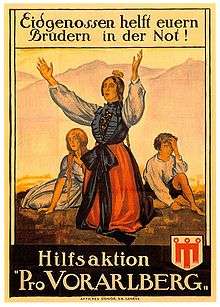
Before the Romans conquered Vorarlberg, there were two Celtic tribes settled in this area: the Raeti in the highlands, and the Vindelici in the lowlands, i.e. the Lake Constance region and the Rhine Valley. One of the important settlements of the Vindelici was Brigantion (modern Bregenz), founded around 500 BC. The first settlements in and around Bregenz date from 1500 BC. A Celtic tribe named "Brigantii" is mentioned by Strabo as a sub-tribe in these region of the Alps.[29] The area of Vorarlberg was conquered by the Romans in 15 BC and it became part of the Roman province of Raetia. It was later conquered by Allemanic tribes in c. 450 AD.
It then fell under the rule of the Bavarians and was subsequently settled by the Bavarians and the Lombards. It later fell under the rule of the Counts of Bregenz until 1160 and then to the Counts of Montfort until 1525, when the Habsburgs took control.[23]
The historically-Germanic province, which was a gathering-together of former bishoprics, was still ruled in part by a few semi-autonomous counts and surviving prince-bishops until the start of World War I. Vorarlberg was a part of Further Austria, and parts of the area were ruled by the Counts Montfort of Vorarlberg.
Following World War I there was a desire by many in Vorarlberg to join Switzerland.[30] In a referendum held in Vorarlberg on 11 May 1919, over 80% of those voting supported a proposal for the state to join the Swiss Confederation. However this was prevented by the opposition of the Austrian government, the Allies, Swiss liberals, the Swiss-Italians and the Swiss-French.[23][31]
Following the Second World War Vorarlberg found itself occupied by French troops from 1945 to 1955, along with most of the federal state of Tyrol.
Notable people
- Franz Michael Felder (*1839, †1869), writer, farmer, social reformer
- Franz Anton Beer (*1688, †1749), baroque master builder
- Artur Doppelmayr (*1922, †2017), entrepreneur and cableway pioneer (see Doppelmayr)
- Michael Köhlmeier (*1949), writer
- Hans-Jörg Schelling (*1953), ÖVP-politician and Austrian's Federal Minister of Finance (2014-2017)
- Ingrid Thurnher (*1962), ORF-anchorwoman
- Stefan Sagmeister (*1962), graphic designer and typographer
Notes
- ↑ Chamber of Commerce Vorarlberg. "Vorarlberg in Figures 2016 Edition" (PDF). Archived from the original (PDF) on 2016-08-04. Retrieved 2017-02-24.
- ↑ "LEITBILD 2010+ / WIRTSCHAFT / VORARLBERG" (PDF). 2018-08-14.
- ↑ KäseStrasse Bregenzerwald (in German)
- ↑ "Vorarlberger Illwerke AG". Vorarlberger Illwerke AG (in German). Retrieved 2018-08-14.
- ↑ "Bregenzerwälder Tracht - Tourismus Schwarzenberg". www.schwarzenberg.at (in German). 2018-07-19. Retrieved 2018-08-13.
- ↑ Bitschnau, Christian. "Vorarlberger Landestrachtenverband: Welcome". www.trachtenverband.at (in German). Retrieved 2018-08-13.
- ↑ "Vorarlberg recipes". Urlaub in Vorarlberg. Retrieved 2018-08-13.
- ↑ "Cheese specialities from Vorarlberg - A mini study of cheeses". Urlaub in Vorarlberg. Retrieved 2018-08-13.
- 1 2 Dangel, Ulrich (2010). Sustainable Architecture in Vorarlberg: Energy Concepts and Construction Systems. Birkhäuser. ISBN 3034604912.
- ↑ "vai". v-a-i.at (in German). Retrieved 2018-08-11.
- ↑ "LCT ONE – LifeCycle Tower, Dornbirn | Architekten Hermann Kaufmann ZT GmbH". www.hkarchitekten.at. Retrieved 2018-08-11.
- ↑ "Getting Things Done: Exhibition description". Getting Things Done. 2017-03-27. Retrieved 2018-06-26.
- ↑ "11 recommended individual architecture trails in Vorarlberg". Urlaub in Vorarlberg. Retrieved 2018-06-26.
- ↑ "Vorarlberg, Austria: Art, Architecture and the Culture of Craftsmanship". Borders Of Adventure. 2017-04-20. Retrieved 2018-08-11.
- ↑ Schwiglhofer, Petra. "Der Staatspreis PR 2014 geht an BUS:STOP Krumbach - PRVA Public Relations Verband Austria". prva.at (in German). Retrieved 2018-06-26.
- ↑ Hendel, archINFORM – Sascha. "Vorarlberger Bauschule". archINFORM (in German). Retrieved 2018-08-11.
- ↑ Schwarz, Harald. "Gemeinde AU: Im Überblick". www.gemeinde-au.at. Retrieved 2018-08-11.
- ↑ "Designer Hotels Modern Architecture – Vorarlberg Tourism, Austria". Retrieved 2017-02-24.
- ↑ WKO Vorarlberg. "Vorarlberg in Figures 2016 Edition" (PDF). Archived from the original (PDF) on 2016-08-04. Retrieved 2017-02-24.
- ↑ "Ski Ride Vorarlberg". Retrieved 2018-09-13.
- ↑ "Vorarlberg - best suggestions for hiking and enjoying nature in Austria". Urlaub in Vorarlberg. Retrieved 2018-08-13.
- ↑ "9 breathtaking walking trails in Vorarlberg, Austria". Wanderlust. Retrieved 2018-08-13.
- 1 2 3 The Free Dictionary by Farlex: Vorarlberg
- ↑ "Biosphere Park Concept". Retrieved 2018-08-13.
- ↑ "Bregenz Festival | 18 July to 20 August 2018". bregenzerfestspiele.com. Retrieved 2018-08-13.
- ↑ GmbH, Poolbar Festival. "poolbar.at". poolbar.at. Retrieved 2018-08-13.
- ↑ "Schubertiade – Announcements". www.schubertiade.at. Retrieved 2018-08-13.
- ↑ "Cultural Scene Vorarlberg - Events and tradition - Bregenz Festival - Austria". Urlaub in Vorarlberg. Retrieved 2018-08-13.
- ↑ Strabo, Geographia Book IV Chap. 6
- ↑ 1982 edition of Encyclopædia Britannica, "History of Austria"
- ↑ "C2D - Centre d'études et de documentation sur la démocratie directe". Archived from the original on 27 February 2007. Retrieved 27 February 2007.
External links
| Wikimedia Commons has media related to Vorarlberg. |
| Wikivoyage has a travel guide for Vorarlberg. |
.svg.png)
